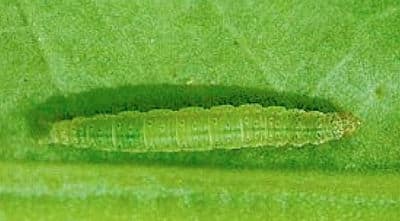Diamondback moth larvae are generally low across the Prairies so far, but one hot spot has been noted in Rural Municipality 10 in Saskatchewan. This R.M. is south of Regina, near the U.S. border. Some populations of diamondback moth above the economic threshold have also been found in Eastern Manitoba recently.
This is a reminder that outbreaks of any pest can be fairly local, so your own field scouting is recommended in addition to the provincial monitoring programs.
Distinguishing features: Diamondback moth larvae are yellowish-green to green, up to half an inch long, and have a small fork-shape on their rear end. When disturbed, the larvae will wriggle backward violently and may drop from the plant, suspended by a silken thread.

Diamondback moths have multiple generations per summer, so larvae can be found earlier in the season and can sometimes cause economic damage due to defoliation. However, feeding on the exterior of developing pods is generally responsible for their “economic” pest status.
The threshold for flowering or podded plants is 200 to 300 diamondback moth larvae per square metre (20 to 30 per square foot). For easier counting, pull up all plants from one square foot and beat them on flat surface, such as a sheet or truck hood, to dislodge them. The Canola Encyclopedia has more on diamondback moth larvae scouting and thresholds.

